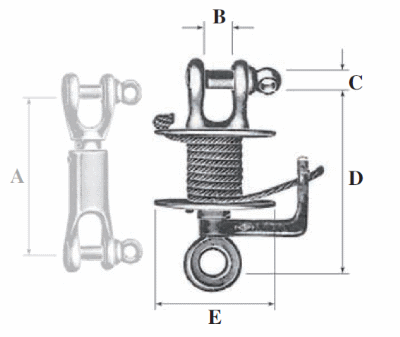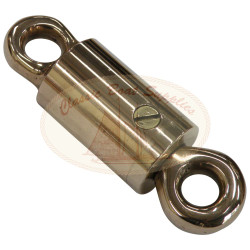Description
Wykeham Martin drum available in four sizes according to sail area (see table below). This bronze self-furling drum pairs with the bronze Wykeham Martin top swivel (sold separately) to create a complete bronze furling system in the traditional style.
In continuous production for over 100 years, Wykeham Martin traditional furling gear has been successfully fitted to thousands of boats worldwide.
Cast in bronze from the original patterns, the parts are carefully machined, polished and assembled by English craftsmen to produce a beautiful and efficient furling system.
Fitted with stainless steel thrust races to ensure free running and easy sail furling. For more information see the information booklet.
SKU | Size | Approx Sail Area | A | B | C | D | E | Davey Product Code | |
| 026801 | 1 | 50 sq.ft. (5 sq.m) | 72mm | 10mm | eye | 85mm | 62mm | 9443/GM/01/DR |
| 026803 | 2B | 100 sq.ft. (10 sq.m) | 100mm | 18mm | 11mm | 128mm | 85mm | 9443/GM/2B/DR |
| 026805 | 3B | 200 sq.ft. (20 sq.m) | 110mm | 20mm | 12mm | 135mm | 95mm | 9443/GM/3B/DR |
| 026807 | 4B | 350 sq.ft. (35 sq.m) | 150mm | 28mm | 16mm | 165mm | 150mm | 9443/GM/4B/DR |

SETTING THE SAIL
- Choose a quiet time of day with little wind.
- On the ground, roll the sail around the wire luff and lash it so that it cannot unroll. Ensure that any sacrificial strip is correctly positioned and that, when installed, the drum and sail will rotate in a clockwise direction, when viewed from above, when furling. This is to ensure that the twisting of the luff wire will go with the lay rather than against it. If furling against the lay of the wire, there is a tendency to untwist the strands of the wire causing possible fatigue and fraying later, which may damage the sail. Check the lay of your wire before starting. Fix the two parts of the gear to the sail and the boat and hoist the sail with a moderate tension in the wire.
- Fix the sheets to the sail after winding them around the rolled up sail 2 or 3 times.
- Pass the furling line from the cockpit, via a fairlead and the hole in the arm, to the drum. Pass the line around the drum four or five times and then through the little hole in the top flange of the drum. Use an overhand or figure of eight knot to stop it pulling out. Note that, with the sail raised and some tension on the sheet, the final position of the fairlead should allow for the line to leave the drum at 90 degrees, with the fairlead bisecting the angle of the turn of the line to reduce friction. (see diagram).
- Untie the lashing on the sail. Keep a little tension on the furling line while you pull on the sheet to unroll the sail. This will pull the furling line onto the drum as the sail is pulled out.
- When the sail is right out you can find the best position to fix a lashing (if you are using this method) to prevent the arm from turning.
Now check that the sail will furl up correctly. Keep a little tension on the sheet while you pull steadily on the furling line. The sail should roll up neatly, finishing with 2 turns of the sheets around the sail, which will keep the sail secure until you have time to fix a sail-tie. If the set is correct, you should still have 4 or 5 turns of furling line on the drum.
NOTES:
- Do not forget to look up at the top swivel to check that it is not twisting the halyard.
- Do not allow the furling line to become slack at any time, as there is a risk that it will fall off the drum. A cam-cleat at the cockpit end of the line is a convenient way of holding it.
- When you leave the boat, make sure that the furled sail is tied up with a sail tie. If you have a sacrificial strip on the sail, check that it is on the outside of the rolled up sail.
1 Review
-
Great product
This is the second boat that i have fitted this furler to. It looks gorgeous, is very strong and very simple to install and operate. The bronze can be kept polished, but i like it to weather gracefully.






